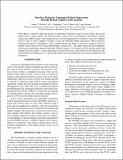Interface Design for Unmanned Vehicle Supervision through Hybrid Cognitive Task Analysis
Author(s)
Macbeth, Jamie C.; Cummings, M. L.; Bertuccelli, Luca F.; Surana, Amit
DownloadCummings_Interface design.pdf (1.367Mb)
OPEN_ACCESS_POLICY
Open Access Policy
Creative Commons Attribution-Noncommercial-Share Alike
Terms of use
Metadata
Show full item recordAbstract
While there is currently significant interest in developing Unmanned Aerial Systems (UASs) that can be supervised by a single operator, the majority of these systems focus on Intelligence, Surveillance, and Reconnaissance (ISR) domains. One domain that has received significantly less attention is the use of multiple UASs to insert or extract supplies or people. To this end, MAVIES (Multi-Autonomous Vehicle Insertion-Extraction System) was developed to allow a single operator the ability to supervise a primary cargo Unmanned Aerial Vehicle (UAV) along with multiple scouting UAVs. This paper will detail the development of the design requirements generated through a Hybrid Cognitive Task Analysis (hCTA) and the display that resulted from these efforts. A major innovation in the hCTA process in this effort was the alteration of the traditional decision ladder process to specifically identify decision-making tasks that must be augmented with automation.
Date issued
2012-10Department
Massachusetts Institute of Technology. Department of Aeronautics and Astronautics; Massachusetts Institute of Technology. Humans and Automation LabJournal
Proceedings of the Human Factors and Ergonomics Society 56th Annual Meeting
Publisher
Human Factors and Ergonomics Society
Citation
Macbeth, Jamie C. et al. "Interface Design for Unmanned Vehicle Supervision through Hybrid Cognitive Task Analysis." Human Factors and Ergonomics Society 56th Annual Meeting, October 2012.
Version: Author's final manuscript
ISSN
1541-9312